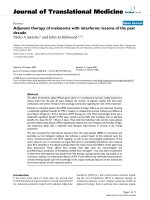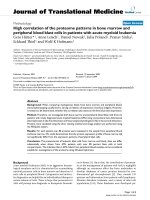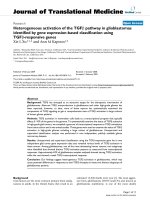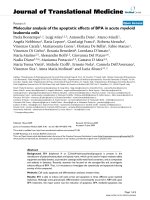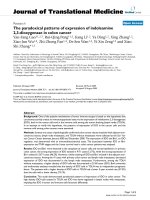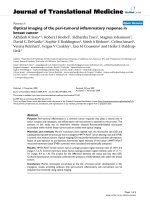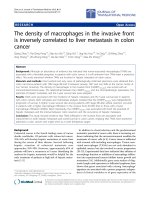Báo cáo hóa học: "The density of macrophages in the invasive front is inversely correlated to liver metastasis in colon cancer" docx
Bạn đang xem bản rút gọn của tài liệu. Xem và tải ngay bản đầy đủ của tài liệu tại đây (942.32 KB, 9 trang )
RESEARC H Open Access
The density of macrophages in the invasive front
is inversely correlated to liver metastasis in colon
cancer
Qiang Zhou
1,2
, Rui-Qing Peng
1,2
, Xiao-Jun Wu
1,3
, Qing Xia
1,2
, Jing-Hui Hou
1,4
, Ya Ding
1,2
, Qi-Ming Zhou
1,2
,
Xing Zhang
1,2
, Zhi-Zhong Pang
1,3
, De-Sen Wan
1,3
, Yi-Xin Zeng
1,2
, Xiao-Shi Zhang
1,2*
Abstract
Background: Although an abundance of evidence has in dicated that tumor-associa ted macrophages (TAMs) are
associated with a favorable prognosis in patients with colon cancer, it is still unknown how TAMs exert a protective
effect. This study examined whether TAMs are involved in hepatic metas tasis of colon cancer.
Materials and methods: One hundred and sixty cases of pathologically-confirmed specimens were obtained from
colon carcinoma patients with TNM stage IIIB and IV between January 1997 and July 2004 at the Cancer Center of
Sun Yat-Sen University. The density of macrophages in the invasive front (CD68TF
Hotspot
) was scored with an
immunohistochemical assay. The relationship between the CD68TF
Hotspot
and the clinicopathologic parameters, the
potential of hepatic metastasis, and the 5-year survival rate were analyzed.
Results: TAMs were associated with the incidence of hepatic metastasis and the 5-year survival rate in patients
with colon cancers. Both univariate and multivariate analyses revealed that the CD68TF
Hotspot
was independently
prognostic of survival. A higher 5-year survival rate among patients with stage IIIB after radical resection occurred
in patients with a higher macrophage infiltration in the invasive front (81.0%) than in those with a lower
macrophage infiltration (48.6%). Most importantly, the CD68TF
Hotspot
was associated with both the potential of
hepatic metastasis and the interval between colon resection and the occurrence of hepatic metastasis.
Conclusion: This study showed evidence that TAMs infiltrated in the invasive front are associated with
improvement in both hepatic metastasis and overall survival in colon cancer, implying that TAMs have protective
potential in colon cancers and might serve as a novel therapeutic target.
Background
Colorectal cancer is the fourth leading cause of cancer
deaths worldwide. Of patients with colorectal cancer,
35%-55% will develop h epatic metastases at some time
during the course of their disease. Survival following
hepatic resection of colorectal metastasis now
approaches 35%-50%. However, approximately 65% of
patients will have a recurrence at 5 years. Identifying the
markers for hepatic metastasis would be helpful for the
early treatment of patients at high-risk of hepatic metas-
tasis [1-5].
In addition to clonal selection and the predeter mined
metastatic potential of cancer cells, there is increasing evi-
dence indicating that the microenvironment modifies the
metastasis of cancer cells [6-9]. Cancer tissue is infiltrated
with stromal cells including macrophages. Tumor- asso-
ciated macrophages (TAMs) are not only abundant in
epithelial cancers, but also involved in cancer progression
[10-13]. Experimental data have indicated that ablation of
macrophage function or inhibition of macrophage infiltra-
tion into experimental tumors inhibits tumor growth and
metastases [14]. Additionally, gene array studies of diag-
nostic lymph node specimens in follicular lymphoma have
shown that genes associated with a strong ‘macrophage’
signature are associated with a poorer prognosis, indepen-
dent of clinical variables or of gene expression of the
* Correspondence:
1
State Key Laboratory of Oncology in South China, Cancer Center, Sun Yat-
Sen University, 651 Dongfeng R E, 510060, Guangzhou, China
Zhou et al. Journal of Translational Medicine 2010, 8:13
/>© 2010 Zhou et al; licensee BioMed Central Ltd. This is an Open Access article distrib uted under the terms of the Creative Commons
Attribution License (http:// creativecommons.org/licenses/by/2.0), which permits unrestricted use, distribution, and reproduction in
any medium, provided the original work is properly cited.
tumor cells [15]. Therefore, TAMs might promote tumor
progression by induction of chronic inflammation, matrix
remodeling, tumor invasion, intravasation, angiogenesis,
and seeding at distant sites [13]. In contrast, recruitment
of TAMs also contributes to the development of an adap-
tive immune response against cancer. TAMs contribute to
the balance between antigen availability and clearance
through phagocytosis and subsequent degradation of
senescent or apoptotic cells. The role of TAMs is essential
for triggering, instructing, and terminating the adaptive
immune response [16]. The clinical evidence regarding the
relationship between TAMsandtumorprogressionis
tumor type-dependent. The higher density of TAMs is
associat ed with a poorer prognosis in lei omyosa rcomas,
melanomas, gliomas, and cancers of the breast, bladder,
rectum, and endometrium, but the prognosis is favorable
in nasopharyngeal, gastric, and ovarian cancers [17-28].
Additionally, in liver, lung, and prostate cancers, the role
of TAMs on prognosis is controversial [29-35].
With respect to colorectal carcinomas, clinical data
indicate that TAMs are associated with a favorable
prognosis [36-39]. However, these studies have not indi-
cated the sites at which TAMs show a protective effect.
Because macrophages modify tumor invasion, intravasa-
tion, and angiogenesis, whether or not TAMs interfere
with hepatic metastasis of colon cancer was determined
in the current study.
Materials and methods
Materials
One hundred and sixty cases of pathologically-con-
firmed specimens were obtained from colon carcinoma
patients with TNM stage IIIB and I V between January
1997 and July 2004 at the Cancer Center of Sun Yat-
Sen University. Patients with stage IV colon carcinoma
who were enrolled in this study had primary colo n can-
cer with synchronous liver metastasis, irrespective of
extra-hepatic involvement. Ninety-eight patients with
stage IIIB colon carcinoma underwent radical surgery,
while 62 patients with stage IV colon carcinoma under-
went palliative colon resection with or without resection
of hepat ic lesions. None of the patients had undergone
either chemotherapy or radiotherapy before the collec-
tion of the samples. The histopathologic characteristics
of the colon carcinoma tissue specimens were confirmed
by blinded review of the original pathology slides. The
TNM c lassification system of the UICC (edition 6) was
used for clinical staging, and the World H ealth Organi-
zation classification was used for pathologic grading.
The study was conducted in accordance with the Hel-
sinki Declaration and approved by the Ethics Committee
of our institution. Patients were informed of the investi-
gational nature of the study and provided their written
informed consent.
Follow-up of stage IIIB patients and post-operative
treatment
Clinical follow-up was only provided to stage IIIB
patients, as patients with stage IV in this study were a
group with high heterogeneity, including solitary or
multiple liver metastases, and liver only or other sites
involved with metastases; these variables affected the
treatment protocols and eventually the response rate
and prognosis. Ninety-eight patients with stage IIIB
coloncarcinomawereobservedonanevery-3-month
basis during the 1
st
year, once every 6 months in the 2
nd
year, and by telephone or mail communication once
every year thereafter for a tot al of 5 years. If recurrence
or metastasis occurred, 5-FU-based chemotherapy was
administered according to the NCCN guidelines [40].
Overall survival (OS) was defined as the time from sur-
gery to death, or was censored at the last known alive
data. Liver metastasis-free survival (LMFS) was defined
as the time from surgery to liver metastasis.
Immunohistochemistry
The specimens were fixed in formaldehyde and
embedded in paraffin. Only blocks co ntaining the tumor
front were evaluated. Tissue sections o f 5-μmthickness
were cut, dried, deparaffinized, and rehydrated in a ser-
ies of alcohols and xylene before antigen retrieval by
pressure cooker treatment in citrate buffer (pH 6.0) for
3 minutes. After that, we performed endogenous peroxi-
dase blocking through hydrogen peroxide incubation.
Mouse anti-human CD68 monoclonal antibody (mAb)
(PG-M1; DakoCytomation, Glostrup, Denmark) at a
1:300 dilution was used. Immunostaining for CD68 was
performed using EnVision + Dual Link Kit (Dako Cyto-
mation) according to the manufacturer’sinstructions.
The development was performed with a substrate-chro-
mogen solution (3,3’-diaminobenzidine dihydrochloride
[DAB]) for 3-5 minutes (brown reaction product). Sec-
tions were then counterstained with hematoxylin and
mounted in non-aqueous mounting medium.
To analyze macrophage phenotypes, antibodies were
stained as follows: 1) IL-12 mAb (1:30, catalog number:
sc-74147,mouseIgG1,SantaCruzbiotechnology,CA,
USA), 2) human leukocyte antigen (HLA)-DR mAb
(1:300, catalog number: ZM-0136, mouse IgG2b, Zhong-
shan Goldenbridge biotechnology, Beijing, China), 3) IL-
10 Ab (1:400, ab34843, rabbit polyclonal Ab, A bcam), 4)
transforming growth factor beta1 (TGF-b1) mAb (1:800,
catalog number: sc-146, rabbit IgG, Santa Cruz biotech-
nology, CA, USA).
CD68 evaluation
Referring to Forssell’s [36] scoring system, CD68 immu-
nostaining along the tumor front was evaluated over the
whole section (7-10 fields per section) and tumors
Zhou et al. Journal of Translational Medicine 2010, 8:13
/>Page 2 of 9
containing small areas among which the infiltration of
CD68-positive cells was considerably above the average
level of CD68-positive cells was defined as CD68 hot-
spots (CD68TF
Hotspot
) [ 36]. All sections were evaluated
far from necrosis areas and H.E. staining was reviewed
in case of uncertain ty. The CD6 8TF
Hotspot
of the two
highest view fields measured at ×200 magnification was
semi-quantitatively graded as no/weak (grade 1), moder-
ate (grade 2), s trong /robust (grade 3), and massive infil-
tration (grade 4). Tumors classified as 1 included
completely negative specimens, as well as specimens
containing some scattered CD68-positive cells along the
tumor margin. Tumors were classified as 2 when CD68
staining was continuous along the t umor margin, but
was not extended from the tumor front more than one
cell layer o n average. CD68 staining that, on average,
extended 2-3 cell layers from the tumor margin over the
whole section was classified as 3, whereas to be classi-
fied as 4, CD68 staining extended several cell layers
from the tumor margin in all fields. Each section was
scored independently by two independent observers.
Interobserver agreements for the CD68TF
Hotspot
were
81%. Disagreements were re-evaluated until a consensus
decision was made.
Statistical analysis
The relationship between the various clinicopathologic
characteri stics and the CD68TF
Hotspot
parameters were
compared and analyzed using c
2
tests, likelihood ratio,
and linear-by-linear association, as appropriate. The
cumulative survival time was computed using the
Kaplan-Meier method and compared by the log-rank
test. Univariate and multivariat e analyses were based on
the C ox proportional hazards regression model. A two-
tailed P < 0.05 was considered to be statistically signifi-
cant. All statistical a nalyses were performed using SPSS
13.0 software for Windows (SPSS Inc., Chicago, IL,
USA).
Results
CD68 expression
TAMs were stained brown in the cytoplasm. The major-
ity of CD68-positive cells were located in the stroma,
and in particular, along the invasive front. CD68-positive
cells were mostly in apparent direct contact with or
immediately adjacent to tumor cells lining the invasive
front. Although most areas along the invasive front dis-
played a fairly homogeneous CD68+ infilt ration pattern,
there were also tumors containing small areas that
showed CD68 infiltration considerably above the average
grade (CD68TF
Hotspot
). The CD68TF
Hotspot
was semi-
quantitatively graded from 1-4 (Fig. 1).
To identify the phenotype of TAMs, a group of conse-
cutive sections was used to stain with CD68, HLA-DR,
TGF-b1, IL-10, and IL-12. TAMs were popularly stained
with HLA-DR, IL-10, sporadically stained with TGF-b1,
negatively stained with IL-12, indicating that TAMs
were activated without classic M1 or M2 phenotype
(Fig. 2).
Relationship between CD68TF
Hotspot
and clinicopathologic
characteristics
We used the c
2
test to assess the relationship between
the TAMs and clinicopathologic characteristics. The
results showed that the CD68TF
Hotspot
was inversely
correlated with TNM stage, the presence of hepatic
metastasis, and pathologic classification (Table 1). When
hepatic metastasis status was cut into the following
three patterns, the CD68TF
Hotspot
was also highly corre-
lated with the status of hepatic metastasis: no hepatic
metastasis (stage IIIB colon cancer without liver metas-
tasis within 5 years of follow- up), metachronous hepatic
metastasis (stage IIIB colon cancer with liver metastasis
within 5 years of follow-up), and synchronous liver
metastasis (stage IV colon cancer with liver metastasis
before palliative surgery).
Survival analyses
By the end of the 5-year follow-up, 68 of patients with
stage IIIB colon carcinoma were alive, thus the 5-year
survival rate was 69.4%. Based on univariate analysis,
including all stage IIIB patients applicable to survival
analyses (n = 98), age, gender, tumor invasive depth,
pathologic grade, and growth pattern showed no prog-
nostic signif icance for OS and LMFS (Table 2). In con-
trast, the sites of primary tumors, pathologic
classification, and hepatic metastasis were predictors for
OS. The CD68TF
Hotspot
was highly correlated to OS (P
= 0.001; log rank test; data not shown), but not LMFS
(P = 0.221; log rank test; data not shown).
For further analysis, the grade data of the CD68TF
Hot-
spot
were divided into 2 groups (grade 1 and 2 versus 3
and 4) according to Forssell’s protocol [ 36]. Therefore,
cases were regrouped into CD68TF
Hotspot
high (3 and 4)
versus CD68TF
Hotspot
low (1 and 2) macrophage infiltra-
tion. Kaplan-Meier survival curves were then plotted to
further investigate the association with OS. The log-
rank statis tic was used to compar e survival rates. The re
was a positive association between the CD68TF
Hotspot
group and both OS (P < 0.001) and LMFS (P = 0.037;
Fig. 3).
Multivariate Cox proportional hazards analysis
Whether or not the CD68TF
Hotspot
group could serve as
an independent predictor of OS and LMFS was ana-
lyzed. A multivariate Cox proportional hazards analysis
was performed, including gender, age, sites of primary
tumors, invasive depth, grade, pathologic classifications,
Zhou et al. Journal of Translational Medicine 2010, 8:13
/>Page 3 of 9
Figure 1 Representative pictures of CD68TF
Hotspot
in colon cancer patients (200× magnification). Differen t grades of macrophage
infiltration along the tumor front were examined with immunohistochemical assay: A, no/low, B, moderate, C, high, and D, massive. Arrows
point at tumor front.
Figure 2 Representative images of macrophage phenotypes in colon cancer on consecutive sections. Arrows point at tumor front.
Zhou et al. Journal of Translational Medicine 2010, 8:13
/>Page 4 of 9
liver metastasis, growth patterns, and CD68TF
Hotspot
groups. In stage IIIB colon cancers, the high
CD68TF
Hotspot
group had a significantly lower risk for
OS (hazard ratio [HR], 0.433; 95% confidence interval
[CI], 0.194-0.966) and LMFS (HR, 0.265; 95% CI, 0.078-
0.900) than did the low CD68TF
Hotspot
group. Liver
metastasis (HR, 8.144; 95% CI, 3.276-20.250) was an
independent prognostic factor for OS. Additionally,
patients with left colon cancer were prone to hav e a
longer OS, whereas pathologic classification was not
associated with OS (Table 3).
Discussion
By analyzing the relationship between the density of
TAMs and the potential of hepatic metastasis and survi-
val, this study showed that a higher density of macro-
phages in the invasive front of colon cancer was
associated with a higher 5-year survival rate. Most
importantly, the CD68TF
Hotspot
was associated with
both th e incidence of hepatic metastasis and the interval
between colon resection and the occurrence of hepatic
metastasis.
In contrast to other solid tumors, such as b reast can-
cer, most studies have shown that TAMs, especially IL-
12-positive TAMs, inhibit the progression of colon can-
cers [36-39,41-44]. For example, in Forssell’s stu dy [36]
the higher macrophage infiltration along the tumor
front correlated with improved survival in colon cancer
compared to rectal cancer. In the current study, the Cox
model indicated that the CD68TF
Hotspot
was indepen-
dently prognostic. A higher 5-year survival rate after
radical resection occurred in patients with a higher
macrophage infiltration in the invasive front (81.0%)
than in those with a lower macrophage infiltration
(48.6%), which is in agreement with the previous studies
[36-39].
The mechanisms behind the antitumor effects of
TAMs have not been fully elucidated and could poten-
tially be ascribed to the M1 phenotype, whi ch is in part
controlled by the CD4+T cells and the death of cancer
cells [45-47]. TAMs with the M1 ph enotype are charac-
terized by a high capacity to present antigen, high IL-12
and IL-23 production, and high production of toxic
intermediates, such as nitric oxide and reactive oxygen
intermediates. Thus, TAMs with the M1 phenotype are
generally considered potent effector cells which kill
tumor cells [48-51]. In fact, TAMs showed a spectrum
from M1 to M2 phenotypes in murine colon adenocar-
cinoma tumors [52]. This study showed that TAMs
expressed with HLA-DR and IL-10 rather than TGF-b1
and IL-12, consistent with the previous observation
[52]. Although an abundance of evidence relevant to the
molecular mechanisms underlying the anti-tumor effect
of macrophages has been documented, it is still
unknown how TAMs exert a protective effect, except
that one recent study indicated tha t TAMs reduce the
development of peritoneal colorectal carcinoma metas-
tases [36-39,41-44,53]. The current study analyzed the
relationship between the infiltration of TAMs and hepa-
tic metastasis. The results showed that a higher density
of TAMs in the invasive front was associated with
lower synchronous and metachronous hepatic metas-
tases. Since hepatic metastasis of colon cancer is a key
prognostic factor, this study might partly explain the
Table 1 Correlation between CD68TF
Hotspot
and
clinicopathologic characteristics.
Variable CD68TF
Hotspot
P value
-/+ + ++ +++
123 4
Gender
Male 23 21 37 13 0.939
Female 15 13 27 11
Age (years)
< 60 22 17 26 15 0.195
≥ 60 16 17 38 9
Sites of primary tumors
Left 25 14 40 16 0.107
Right 13 20 24 8
TNM stages
IIIB 17 18 46 17 0.025*
IV 21 16 18 7
Invasive depth
T3 31 30 53 17 0.422
a
T4 7 4 11 7
Hepatic metastasis(1)
No 13 14 42 16 0.004*
Yes 25 20 22 8
Hepatic metastasis(2)
No 13 14 42 16 0.001*
b
Metachronous 4 4 4 1
Synchronous 21 16 18 7
Grade
G1 1 1 1 0 0.124
b
G2 23 21 48 21
G3 14 11 14 2
G4 0 1 1 1
Pathologic classification
Papillary + tubular 28 25 57 23 0.022*
a
Mucoid + signet ring 10 9 7 1
Growth pattern
Pushing 19 8 18 8 0.071
Infiltrating 19 26 46 16
*: p < 0.05. a: Likelihood ratio. b: Exact linear-by-linear association test.
Zhou et al. Journal of Translational Medicine 2010, 8:13
/>Page 5 of 9
reason that macrophage infiltration improves the prog-
nosis of patients with colon cancer.
The molecular mechanisms underlying hepatic metas-
tasis of colon cancers is poorly understood. Traditional
clinicopath ologic indices for hepatic metastasis of color-
ectal cancer, which include the depth of invasion, the
presence of venous invasion, and lymph node metastasis,
have only limited prognostic value [54]. Although multi-
ple markers, such as CD10, CD44, VEGF, TGF-a,have
been shown to be correlated with hepatic metastasis, the
predictive efficacy of these markers is still unclear
[55-60]. In the current study, a h igher density of TAMs
in the invasive front was associated with lower synchro-
nous hepatic metastasis and lower metachronous hepatic
metastasis, showing that the immune microenvironment
of the primary tumor modifies the me tastatic potential
of colon cancer, and the function of TAMs is change-
able in different tumor microenvironment [61].
Most immune cells, such as CD45RO+T cells, CD3
+T cells, NK cells, TAMs, and even Treg cells, have
shown a protective effect when infiltrated into colon
cancer tissue [62-67]. Additionally, an a utoimmune
response is associated with the efficacy of biochem-
otherapy (GOLFIG regimen) for colon cancer [68,69].
The current stud y has given addition al evidence that
macrophage infiltration is involved in the inhibition of
hepatic metastasis. These data indicate that colon can-
cer is an immunogenic tumor. Therefore, more
Table 2 Univariate analyses of factors associated with OS and LMFS.
Variable OS (n = 98) LMFS (n = 98)
HR, (95% CI) P value HR, (95% CI) P value
Gender (female vs. male) 1.157 (0.562-2.381) 0.693 0.416 (0.114-1.510) 0.182
Age (< 60 y vs. ≥ 60 y) 0.732 (0.352-1.519) 0.402 0.704 (0.230-2.153) 0.538
Invasive depth (T4 vs. T3) 1.023 (0.392-2.674) 0.962 0.902 (0.200-4.068) 0.893
Sites of primary tumors (right vs. left) 2.271 (1.093-4.717) 0.028* 0.815 (0.267-2.491) 0.720
Grade (G3 vs. G2 vs. G1) 1.519 (0.715-3.224) 0.277 1.036 (0.324-3.311) 0.953
Pathologic classification (mucoid + signet ring vs. papillary + tubular) 2.415 (1.129-5.168) 0.023* 1.148 (0.316-4.171) 0.834
Growth pattern (infiltrating vs. pushing) 0.817 (0.389-1.718) 0.595 2.709 (0.600-12.223) 0.195
CD68TF
Hotspot
(4 vs. 3 vs. 2 vs.1) 0.568 (0.393-0.822) 0.003* 0.594 (0.344-1.025) 0.061
CD68TF
Hotspot
group (high vs. low) 0.288 (0.139-0.600) 0.001* 0.324 (0.106-0.991) 0.048*
Hepatic metastasis (yes vs. no) 5.852 (2.737-12.511) 0.000** NA NA
Univariate analysis, Cox proportional hazards regression model. Abbreviations: HR, hazard ratio; CI, confidence interval; NA, not assessment. *: p<0.05;**:p<
0.001.
Figure 3 Kaplan–Meier analysis of overall survival (A) and liver metastasis-free survival (B) for CD68TF
Hotspot
group. The patients with a
higher CD68TF
Hotspot
group (solid lines) were associated with longer 5-year overall survival and liver metastasis-free survival than those with a
lower CD68TF
Hotspot
group (dashed lines).
Zhou et al. Journal of Translational Medicine 2010, 8:13
/>Page 6 of 9
attention should be paid to e xploiting the immune
response in an effort to improve conventio nal therapy
for colon cancer [70].
Additionally, our study main aim is to find if there any
relationship between macrophages a nd liver metas tasis
in colon cancer which was cut into the following three
patterns: no hepatic metastasis, metachronous and syn-
chronous liver metastasis. We decided to choose single
stage IIIB colon cancer which is the biggest group in
our center colon resource database t o avoid the influ-
ence of different stages factor on relationship between
macrophages and liver metastasi s. Although this consti-
tution minimized confound ing factors, it cannot com-
pletely represent ordinary setup, so our results, and as
such, should be viewed with some caution.
Conclusion
This study demonstrated that TAMs infiltrated in the
invasive front are associated with improvement in both
hepatic metastasis and OS in colon cancer, implying
that TAMs have protective potential in colon cancers
and might serve as a novel therapeutic target.
Acknowledgements
This study was supported by research grants from the National Nature
Science Foundation (30972882) and the Nature Science Foundation of
Guangdong Province, China (9151008901000149).
Author details
1
State Key Laboratory of Oncology in South China, Cancer Center, Sun Yat-
Sen University, 651 Dongfeng R E, 510060, Guangzhou, China.
2
Biotherapy
Center, Cancer Center, Sun Yat-Sen University, 651 Dongfeng R E, 510060,
Guangzhou, China.
3
Department of Colorectal Oncology, Cancer Center, Sun
Yat-Sen University, 651 Dongfeng R E, 510060, Guangzhou, China.
4
Department of Pathology, Cancer Center, Sun Yat-Sen University, 651
Dongfeng R E, 510060, Guangzhou, China.
Authors’ contributions
WXJ, DY, ZQM, PZZ, and WDS carried out the case collection; ZQ, XQ, and
HJH carried out the immunohistochemical staining; and PRQ and ZX
analyzed the results. ZXS and ZYX conceived the study, participated in the
design, and coordinated and helped draft the manuscript. All authors read
and approved the final manuscript.
Competing interests
The authors declare that they have no competing interests.
Received: 3 November 2009
Accepted: 8 February 2010 Published: 8 February 2010
References
1. Mayo SC, Pawlik TM: Current management of colorectal hepatic
metastasis. Expert Rev Gastroenterol Hepatol 2009, 3(2):131-144.
2. Duffy MJ, van Dalen A, Haglund C, Hansson L, Holinski-Feder E, Klapdor R,
Lamerz R, Peltomaki P, Sturgeon C, Topolcan O: Tumour markers in
colorectal cancer: European Group on Tumour Markers (EGTM)
guidelines for clinical use. Eur J Cancer 2007, 43(9):1348-1360.
3. Shah A, Alberts S, Adam R: Accomplishments in 2007 in the management
of curable metastatic colorectal cancer. Gastrointest Cancer Res 2008, 2(3
Suppl):S13-18.
4. Shrivastav A, Varma S, Saxena A, DeCoteau J, Sharma RK: N-
myristoyltransferase: a potential novel diagnostic marker for colon
cancer. J Transl Med 2007, 5:58.
5. Lind GE, Ahlquist T, Kolberg M, Berg M, Eknaes M, Alonso MA, Kallioniemi A,
Meling GI, Skotheim RI, Rognum TO, Thiis-Evensen E, Lothe RA:
Hypermethylated MAL gene - a silent marker of early colon
tumorigenesis. J Transl Med 2008, 6:13.
6. Eccles SA, Welch DR: Metastasis: recent discoveries and novel treatment
strategies. Lancet 2007, 369(9574):1742-1757.
7. Li CY, Li BX, Liang Y, Peng RQ, Ding Y, Xu DZ, Zhang X, Pan ZZ, Wan DS,
Zeng YX, Zhu XF, Zhang XS: Higher percentage of CD133+ cells is
associated with poor prognosis in colon carcinoma patients with stage
IIIB. J Transl Med 2009, 7:56.
8. Gao YF, Peng RQ, Li J, Ding Y, Zhang X, Wu XJ, Pan ZZ, Wan DS, Zeng YX,
Zhang XS: The paradoxical patterns of expression of indoleamine 2,3-
dioxygenase in colon cancer. J Transl Med 2009, 7:71.
9. Kopfstein L, Christofori G: Metastasis: cell-autonomous mechanisms versus
contributions by the tumor microenvironment. Cell Mol Life Sci 2006,
63(4):449-468.
10. Hallam S, Escorcio-Correia M, Soper R, Schultheiss A, Hagemann T:
Activated macrophages in the tumour microenvironment-dancing to the
tune of TLR and NF-kappaB. J Pathol 2009, 219(2):143-152.
11. Hagemann T, Lawrence T, McNeish I, Charles KA, Kulbe H, Thompson RG,
Robinson SC, Balkwill FR: “Re-educating” tumor-associated macrophages
by targeting NF-kappaB. J Exp Med 2008, 205(6):1261-1268.
12. Hagemann T, Biswas SK, Lawrence T, Sica A, Lewis CE: Regulation of
macrophage function in tumors: the multifaceted role of NF-kappaB.
Blood 2009, 113(14):3139-3146.
Table 3 Multivariate analyses of factors associated with OS and LMFS
Variable OS (n = 98) LMFS (n = 98)
HR, (95% CI) P value HR, (95% CI) P value
Gender (female vs. male) 1.954 (0.841-4.538) 0.119 0.333 (0.083-1.335) 0.121
Age (< 60 y vs. ≥ 60 y) 0.504 (0.227-1.116) 0.091 0.881 (0.267-2.906) 0.835
Invasive depth (T4 vs. T3) 1.941 (0.693-5.436) 0.207 0.846 (0.171-4.190) 0.838
Site of primary tumors (right vs. left) 2.184 (0.981-4.859) 0.056 1.009 (0.298-3.414) 0.989
Grade (G3 vs. G2 vs. G1) 1.224 (0.457-3.281) 0.688 1.616 (0.345-7.575) 0.543
Pathologic Classification (mucoid + signet ring vs. papillary + tubular) 2.364 (0.787-7.100) 0.125 0.537 (0.071-4.061) 0.547
Growth patterns (infiltrating vs. pushing) 0.700 (0.295-1.662) 0.419 2.650 (0.551-12.746) 0.224
CD68TF
Hotspot
group (high vs. low) 0.433 (0.194-0.966) 0.041* 0.265 (0.078-0.900) 0.033*
Liver metastasis (yes vs. no) 8.144 (3.276-20.250) 0.000** NA NA
Multivariate analysis, Cox proportional hazard regression model. Abbreviations: HR, hazard ratio; CI, confidence interval; NA, not assessm ent. *: p < 0.05; **: p <
0.001.
Zhou et al. Journal of Translational Medicine 2010, 8:13
/>Page 7 of 9
13. Condeelis J, Pollard JW: Macrophages: obligate partners for tumor cell
migration, invasion, and metastasis. Cell 2006, 124(2):263-266.
14. Lin EY, Nguyen AV, Russell RG, Pollard JW: Colony-stimulating factor 1
promotes progression of mammary tumors to malignancy. J Exp Med
2001, 193(6):727-740.
15. Dave SS, Wright G, Tan B, Rosenwald A, Gascoyne RD, Chan WC, Fisher RI,
Braziel RM, Rimsza LM, Grogan TM, Miller TP, LeBlanc M, Greiner TC,
Weisenburger DD, Lynch JC, Vose J, Armitage JO, Smeland EB, Kvaloy S,
Holte H, Delabie J, Connors JM, Lansdorp PM, Ouyang Q, Lister TA,
Davies AJ, Norton AJ, Muller-Hermelink HK, Ott G, Campo E, Montserrat E,
Wilson WH, Jaffe ES, Simon R, Yang L, Powell J, Zhao H, Goldschmidt N,
Chiorazzi M, Staudt LM: Prediction of survival in follicular lymphoma
based on molecular features of tumor-infiltrating immune cells. N Engl J
Med 2004, 351(21):2159-2169.
16. Siveen KS, Kuttan G: Role of macrophages in tumour progression.
Immunol Lett 2009, 123(2):97-102.
17. Nishie A, Ono M, Shono T, Fukushi J, Otsubo M, Onoue H, Ito Y, Inamura T,
Ikezaki K, Fukui M, Iwaki T, Kuwano M: Macrophage infiltration and heme
oxygenase-1 expression correlate with angiogenesis in human gliomas.
Clin Cancer Res 1999, 5(5):1107-1113.
18. Leek RD, Lewis CE, Whitehouse R, Greenall M, Clarke J, Harris AL:
Association of m acrophage infiltration with angiogenesis and prognosis
in invasive breast carcinoma. Cancer Res 1996, 56(20):4625-4629.
19. Pollard JW: Macrophages define the invasive microenvironment in breast
cancer. J Leukoc Biol 2008, 84(3):623-630.
20. Shabo I, Stål O, Olsson H, Doré S, Svanvik J: Breast cancer expression of
CD163, a macrophage scavenger receptor, is related to early distant
recurrence and reduced patient survival. Int J Cancer 2008,
123(4):780-786.
21. Hanada T, Nakagawa M, Emoto A, Nomura T, Nasu N, Nomura Y:
Prognostic value of tumor-associated macrophage count in human
bladder cancer. Int J Urol 2000, 7(7):263-269.
22. Shabo I, Olsson H, Sun XF, Svanvik J: Expression of the macrophage
antigen CD163 in rectal cancer cells is associated with early local
recurrence and reduced survival time. Int J Cancer 2009, 125(8):1826-1831.
23. Salvesen HB, Akslen LA: Significance of tumour-associated macrophages,
vascular endothelial growth factor and thrombospondin-1 expression
for tumour angiogenesis and prognosis in endometrial carcinomas. Int J
Cancer 1999, 84(5):538-543.
24. Lee CH, Espinosa I, Vrijaldenhoven S, Subramanian S, Montgomery KD,
Zhu S, Marinelli RJ, Peterse JL, Poulin N, Nielsen TO, West RB, Gilks CB,
Rijn van de M: Prognostic significance of macrophage infiltration in
leiomyosarcomas. Clin Cancer Res 2008, 14(5):1423-1430.
25. Jensen TO, Schmidt H, Møller HJ, Høyer M, Maniecki MB, Sjoegren P,
Christensen IJ, Steiniche T: Macrophage markers in serum and tumor
have prognostic impact in American Joint Committee on Cancer stage I/
II melanoma. J Clin Oncol 2009, 27(20):3330-3337.
26. Ohno S, Inagawa H, Dhar DK, Fujii T, Ueda S, Tachibana M, Suzuki N,
Inoue M, Soma G, Nagasue N: The degree of macrophage infiltration into
the cancer cell nest is a significant predictor of survival in gastric cancer
patients.
Anticancer Res 2003, 23(6D):5015-5022.
27. Tanaka Y, Kobayashi H, Suzuki M, Kanayama N, Suzuki M, Terao T:
Upregulation of bikunin in tumor-infiltrating macrophages as a factor of
favorable prognosis in ovarian cancer. Gynecol Oncol 2004, 94(3):725-734.
28. Peng J, Ding T, Zheng LM, Shao JY: Influence of tumor-associated
macrophages on progression and prognosis of nasopharyngeal
carcinoma. Ai Zheng 2006, 25(11):1340-1345, [Article in Chinese].
29. Ding T, Xu J, Wang F, Shi M, Zhang Y, Li SP, Zheng L: High tumor-
infiltrating macrophage density predicts poor prognosis in patients with
primary hepatocellular carcinoma after resection. Hum Pathol 2009,
40(3):381-389.
30. Li YW, Qiu SJ, Fan J, Gao Q, Zhou J, Xiao YS, Xu Y, Wang XY, Sun J,
Huang XW: Tumor-infiltrating macrophages can predict favorable
prognosis in hepatocellular carcinoma after resection. J Cancer Res Clin
Oncol 2009, 135(3):439-449.
31. Kawai O, Ishii G, Kubota K, Murata Y, Naito Y, Mizuno T, Aokage K, Saijo N,
Nishiwaki Y, Gemma A, Kudoh S, Ochiai A: Predominant infiltration of
macrophages and CD8(+) T Cells in cancer nests is a significant
predictor of survival in stage IV nonsmall cell lung cancer. Cancer 2008,
113(6):1387-1395.
32. Welsh TJ, Green RH, Richardson D, Waller DA, O’Byrne KJ, Bradding P:
Macrophage and mast-cell invasion of tumor cell islets confers a marked
survival advantage in non-small-cell lung cancer. J Clin Oncol 2005,
23(35):8959-8967.
33. Kataki A, Scheid P, Piet M, Marie B, Martinet N, Martinet Y, Vignaud JM:
Tumor infiltrating lymphocytes and macrophages have a potential dual
role in lung cancer by supporting both host-defense and tumor
progression. J Lab Clin Med 2002, 140(5):320-328.
34. Richardsen E, Uglehus RD, Due J, Busch C, Busund LT: The prognostic
impact of M-CSF, CSF-1 receptor, CD68 and CD3 in prostatic carcinoma.
Histopathology 2008, 53(1):30-38.
35. Lissbrant IF, Stattin P, Wikstrom P, Damber JE, Egevad L, Bergh A: Tumor
associated macrophages in human prostate cancer: relation to
clinicopathological variables and survival. Int J Oncol 2000, 17(3):445-451.
36. Forssell J, Oberg A, Henriksson ML, Stenling R, Jung A, Palmqvist R: High
macrophage infiltration along the tumor front correlates with improved
survival in colon cancer. Clin Cancer Res 2007, 13(5):1472-1479.
37. Nagorsen D, Voigt S, Berg E, Stein H, Thiel E, Loddenkemper C: Tumor-
infiltrating macrophages and dendritic cells in human colorectal cancer:
relation to local regulatory T cells, systemic T-cell response against
tumor-associated antigens and survival. J Transl Med 2007, 5:62.
38. Funada Y, Noguchi T, Kikuchi R, Takeno S, Uchida Y, Gabbert HE:
Prognostic significance of CD8+ T cell and macrophage peritumoral
infiltration in colorectal cancer. Oncol Rep 2003, 10(2):309-313.
39. Sugita J, Ohtani H, Mizoi T, Saito K, Shiiba K, Sasaki I, Matsuno S, Yagita H,
Miyazawa M, Nagura H: Close association between Fas ligand (FasL;
CD95L)- positive tumor-associated macrophages and apoptotic cancer
cells along invasive margin of colorectal carcinoma: a proposal on
tumor-host interactions. Jpn J Cancer Res 2002, 93(3):320-328.
40. National Comprehensive Cancer Network. />professionals/physician_gls/PDF/colon.pdf.
41. Kuniyasu H, Sasaki T, Sasahira T, Ohmori H, Takahashi T: Depletion of
tumor-infiltrating macrophages is associated with amphoterin
expression in colon cancer. Pathobiology 2004, 71(3):129-136.
42. Bacman D, Merkel S, Croner R, Papadopoulos T, Brueckl W, Dimmler A: TGF-
beta receptor 2 downregulation in tumour-associated stroma worsens
prognosis and high-grade tumours show more tumour-associated
macrophages and lower TGF-beta1 expression in colon carcinoma: a
retrospective study. BMC Cancer 2007, 7:156.
43. Inoue Y, Nakayama Y, Minagawa N, Katsuki T, Nagashima N, Matsumoto K,
Shibao K, Tsurudome Y, Hirata K, Nagata N, Itoh H: Relationship between
interleukin-12-expressing cells and antigen-presenting cells in patients
with colorectal cancer. Anticancer Res 2005, 25(5):3541-3546.
44. Tan SY, Fan Y, Luo HS, Shen ZX, Guo Y, Zhao LJ: Prognostic significance of
cell infiltrations of immunosurveillance in colorectal cancer. World J
Gastroenterol 2005, 11(8):1210-1214.
45. Umemura N, Saio M, Suwa T, Kitoh Y, Bai J, Nonaka K, Ouyang GF,
Okada M, Balazs M, Adany R, Shibata T, Takami T: Tumor-infiltrating
myeloid-derived suppressor cells are pleiotropic-inflamed monocytes/
macrophages that bear M1- and M2-type characteristics. J Leukoc Biol
2008, 83(5):1136-1144.
46. Weigert A, Tzieply N, von Knethen A, Johann AM, Schmidt H, Geisslinger G,
Brüne B: Tumor cell apoptosis polarizes macrophages role of
sphingosine- 1-phosphate. Mol Biol Cell 2007, 18(10):3810-3819.
47. DeNardo DG, Barreto JB, Andreu P, Vasquez L, Tawfik D, Kolhatkar N,
Coussens LM: CD4(+) T cells regulate pulmonary metastasis of mammary
carcinomas by enhancing protumor properties of macrophages. Cancer
Cell 2009, 16(2):91-102.
48. Mantovani A, Sica A, Allavena P, Garlanda C, Locati M: Tumor-associated
macrophages and the related myeloid-derived suppressor cells as a
paradigm of the diversity of macrophage activation. Hum Immunol 2009,
70(5):325-330.
49. Sica A, Schioppa T, Mantovani A, Allavena P: Tumour-associated
macrophages are a distinct M2 polarised population promoting tumour
progression: potential targets of anti-cancer therapy. Eur J Cancer 2006,
42(6):717-727.
50. Gordon S, Taylor PR: Monocyte and macrophage heterogeneity. Nat Rev
Immunol 2005, 5(12):953-964.
51. Pollard JW: Trophic macrophages in development and disease. Nat Rev
Immunol 2009, 9(4):259-270.
Zhou et al. Journal of Translational Medicine 2010, 8:13
/>Page 8 of 9
52. Umemura N, Saio M, Suwa T, Kitoh Y, Bai J, Nonaka K, Ouyang GF,
Okada M, Balazs M, Adany R, Shibata T, Takami T: Tumor-infiltrating
myeloid- derived suppressor cells are pleiotropic-inflamed monocytes/
macrophages that bear M1- and M2-type characteristics. J Leukoc Biol
2008, 83(5):1136-1144.
53. Bij van der GJ, Bögels M, Oosterling SJ, Kroon J, Schuckmann DT, de
Vries HE, Meijer S, Beelen RH, van Egmond M: Tumor infiltrating
macrophages reduce development of peritoneal colorectal carcinoma
metastases. Cancer Lett 2008.
54. Bird NC, Mangnall D, Majeed AW: Biology of colorectal liver metastases: A
review. J Surg Oncol 2006, 94(1):68-80.
55. Fang YJ, Lu ZH, Wang GQ, Pan ZZ, Zhou ZW, Yun JP, Zhang MF, Wan DS:
Elevated expressions of MMP7, TROP2, and survivin are associated with
survival, disease recurrence, and liver metastasis of colon cancer. Int J
Colorectal Dis 2009, 24(8):875-884.
56. Barozzi C, Ravaioli M, D’Errico A, Grazi GL, Poggioli G, Cavrini G, Mazziotti A,
Grigioni WF: Relevance of biologic markers in colorectal carcinoma: a
comparative study of a broad panel. Cancer 2002, 94(3):647-657.
57. Kato H, Semba S, Miskad UA, Seo Y, Kasuga M, Yokozaki H: High expression
of PRL-3 promotes cancer cell motility and liver metastasis in human
colorectal cancer: a predictive molecular marker of metachronous liver
and lung metastases. Clin Cancer Res 2004, 10(21):7318-7128.
58. Ohji Y, Yao T, Eguchi T, Yamada T, Hirahashi M, Iida M, Tsuneyoshi M:
Evaluation of risk of liver metastasis in colorectal adenocarcinoma based
on the combination of risk factors including CD10 expression:
multivariate analysis of clinicopathological and immunohistochemical
factors. Oncol Rep 2007, 17(3):525-530.
59. Tanami H, Tsuda H, Okabe S, Iwai T, Sugihara K, Imoto I, Inazawa J:
Involvement of cyclin D3 in liver metastasis of colorectal cancer,
revealed by genome-wide copy-number analysis. Lab Invest 2005,
85(9):1118-1129.
60. Hu H, Sun L, Guo C, Liu Q, Zhou Z, Peng L, Pan J, Yu L, Lou J, Yang Z,
Zhao P, Ran Y: Tumor cell-microenvironment interaction models coupled
with clinical validation reveal CCL2 and SNCG as two predictors of
colorectal cancer hepatic metastasis. Clin Cancer Res 2009,
15(17):5485-5493.
61. Nonaka K, Saio M, Suwa T, Frey AB, Umemura N, Imai H, Ouyang GF,
Osada S, Balazs M, Adany R, Kawaguchi Y, Yoshida K, Takami T: Skewing
the Th cell phenotype toward Th1 alters the maturation of tumor-
infiltrating mononuclear phagocytes. J Leukoc Biol 2008, 84(3):679-688.
62. Laghi L, Bianchi P, Miranda E, Balladore E, Pacetti V, Grizzi F, Allavena P,
Torri V, Repici A, Santoro A, Mantovani A, Roncalli M, Malesci A: CD3+ cells
at the invasive margin of deeply invading (pT3-T4) colorectal cancer and
risk of post-surgical metastasis: a longitudinal study. Lancet Oncol 2009,
10(9):877-884.
63. Pagès F, Berger A, Camus M, Sanchez-Cabo F, Costes A, Molidor R,
Mlecnik B, Kirilovsky A, Nilsson M, Damotte D, Meatchi T, Bruneval P,
Cugnenc PH, Trajanoski Z, Fridman WH, Galon J: Effector memory T cells,
early metastasis, and survival in colorectal cancer. N Engl J Med 2005,
353(25):2654-2666.
64. Salama P, Phillips M, Grieu F, Morris M, Zeps N, Joseph D, Platell C,
Iacopetta B: Tumor-infiltrating FOXP3+ T regulatory cells show strong
prognostic significance in colorectal cancer. J Clin Oncol 2009,
27(2):186-192.
65. Sandel MH, Speetjens FM, Menon AG, Albertsson PA, Basse PH, Hokland M,
Nagelkerke JF, Tollenaar RA, Velde van de CJ, Kuppen PJ: Natural killer cells
infiltrating colorectal cancer and MHC class I expression. Mol Immunol
2005, 42(4):54154-6.
66. Ohtani H: Focus on TILs: prognostic significance of tumor infiltrating
lymphocytes in human colorectal cancer. Cancer Immun 2007, 7:4.
67. Gout S, Huot J: Role of cancer microenvironment in metastasis: focus on
colon cancer. Cancer Microenviron 2008, 1(1):69-83.
68. Correale P, Cusi MG, Tsang KY, Del Vecchio MT, Marsili S, Placa ML,
Intrivici C, Aquino A, Micheli L, Nencini C, Ferrari F, Giorgi G, Bonmassar E,
Francini G: Chemo-immunotherapy of metastatic colorectal carcinoma
with gemcitabine plus FOLFOX 4 followed by subcutaneous granulocyte
macrophage colony- stimulating factor and interleukin-2 induces strong
immunologic and antitumor activity in metastatic colon cancer patients.
J Clin Oncol 2005, 23(35):8950-8958.
69. Correale P, Tagliaferri P, Fioravanti A, Del Vecchio MT, Remondo C,
Montagnani F, Rotundo MS, Ginanneschi C, Martellucci I, Francini E,
Cusi MG, Tassone P, Francini G: Immunity feedback and clinical outcome
in colon cancer patients undergoing chemoimmunotherapy with
gemcitabine + FOLFOX followed by subcutaneous granulocyte
macrophage colony- stimulating factor and aldesleukin (GOLFIG-1 Trial).
Clin Cancer Res 2008, 14(13):4192-499.
70. Stout RD, Watkins SK, Suttles J: Functional plasticity of macrophages: in
situ reprogramming of tumor-associated macrophages. J Leukoc Biol
2009, 86(5):1105-1109.
doi:10.1186/1479-5876-8-13
Cite this article as: Zhou et al.: The density of macrophages in the
invasive front is inversely correlated to liver metastasis in colon cancer.
Journal of Translational Medicine 2010 8:13.
Submit your next manuscript to BioMed Central
and take full advantage of:
• Convenient online submission
• Thorough peer review
• No space constraints or color figure charges
• Immediate publication on acceptance
• Inclusion in PubMed, CAS, Scopus and Google Scholar
• Research which is freely available for redistribution
Submit your manuscript at
www.biomedcentral.com/submit
Zhou et al. Journal of Translational Medicine 2010, 8:13
/>Page 9 of 9

